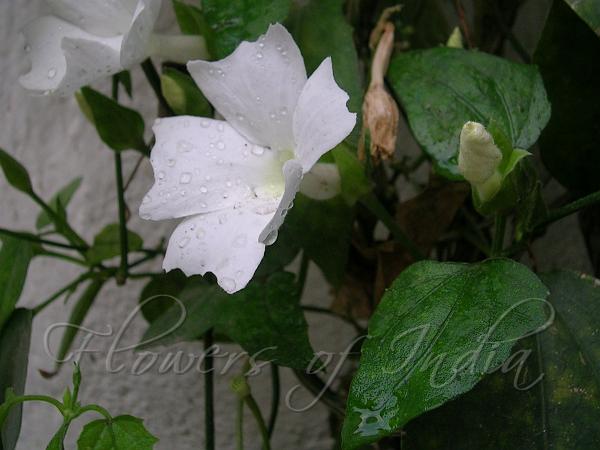|
| Sweet Clock Vine |
|

|

| File size | 291444 |
| Original date | 3/21/07 5:56 PM |
| Resolution | 2048 x 1536 |
| Flash | Flash did not fire, auto |
| Focal length | 8.0mm |
| Exposure time | 1/58s |
| Aperture | 3.2 |
| Focus Distance | |
| Metering Mode | Partial |
| Camera make | NIKON |
| Camera model | E3700 |
| Sensor type |
|
|
|
Photo: |
Botanical name: Thunbergia fragrans Family: Acanthaceae (Acanthus family)
Commonly planted in gardens for its attractive white flowers, this
slender, herbaceous vine, native to India and Sri Lanka, often establishes
itself in thickets, in waste grounds and on roadsides.
Thunbergia commemorates Karl P. Thunberg, an eminent Swedish traveller and
botanist, who lived from 1745 to 1828; the genus was dedicated to him by the
botanist Retz in 1776. Sweet Clock-Vine climbs to a length of 2
meters, or less, and is finely hairy. Its leaves are rather broad,
long-pointed, often coarsely few-toothed, slender-stalked, and from 5 to 10
centimeters long. Flowers are white, 2 inches wide and scentless. There has
been lot of confusion on why the species name is fragrans. Dr.
Roxburgh, who gave the name to this flower, says in his book,
Plants of the Coast of Coromandel:
"the plant possesses a peculiar and agreeable fragrance, and the beauty of its flowers, although not fragrant, entitle it to a place in the flower-garden"
So, the plant possesses a fragrance, but not the flowers.
Medicinal uses: The paste made from tender twigs of the indrapushapa is used to treat
fever and is sometimes applied to cuts and wounds in Indian Siddha
medicine. The leaves are used as a poultice in skin diseases, and their
juice is applied to the head to relieve headaches.
The paste made from tender twigs of the indrapushapa is used to treat
fever and is sometimes applied to cuts and wounds in Indian Siddha
medicine. The leaves are used as a poultice in skin diseases, and their
juice is applied to the head to relieve headaches.
"the plant possesses a peculiar and agreeable fragrance, and the beauty of its flowers, although not fragrant, entitle it to a place in the flower-garden"
So, the plant possesses a fragrance, but not the flowers.
Medicinal uses:
 The paste made from tender twigs of the indrapushapa is used to treat
fever and is sometimes applied to cuts and wounds in Indian Siddha
medicine. The leaves are used as a poultice in skin diseases, and their
juice is applied to the head to relieve headaches.
The paste made from tender twigs of the indrapushapa is used to treat
fever and is sometimes applied to cuts and wounds in Indian Siddha
medicine. The leaves are used as a poultice in skin diseases, and their
juice is applied to the head to relieve headaches.
| Identification credit: K. Karthigeyan, Nandan kalbag | Photographed in Delhi & Manipur. |
• Is this flower misidentified? If yes,